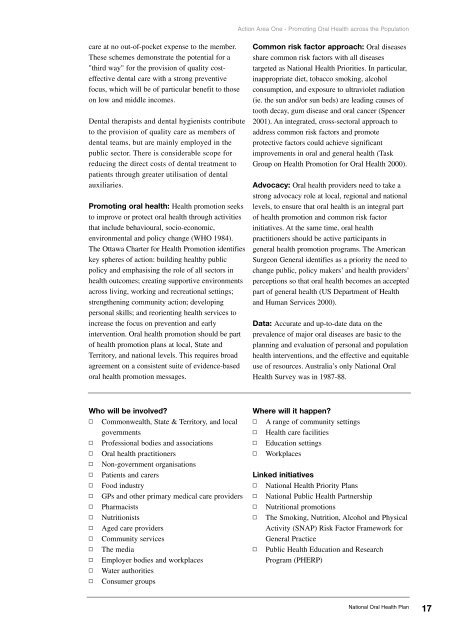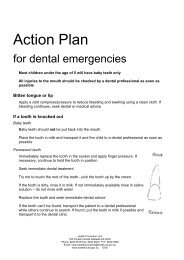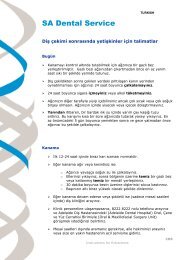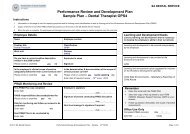National Oral Health Plan - Australian Dental Association
National Oral Health Plan - Australian Dental Association
National Oral Health Plan - Australian Dental Association
You also want an ePaper? Increase the reach of your titles
YUMPU automatically turns print PDFs into web optimized ePapers that Google loves.
Action Area One - Promoting <strong>Oral</strong> <strong>Health</strong> across the Population<br />
care at no out-of-pocket expense to the member.<br />
These schemes demonstrate the potential for a<br />
"third way" for the provision of quality costeffective<br />
dental care with a strong preventive<br />
focus, which will be of particular benefit to those<br />
on low and middle incomes.<br />
<strong>Dental</strong> therapists and dental hygienists contribute<br />
to the provision of quality care as members of<br />
dental teams, but are mainly employed in the<br />
public sector. There is considerable scope for<br />
reducing the direct costs of dental treatment to<br />
patients through greater utilisation of dental<br />
auxiliaries.<br />
Promoting oral health: <strong>Health</strong> promotion seeks<br />
to improve or protect oral health through activities<br />
that include behavioural, socio-economic,<br />
environmental and policy change (WHO 1984).<br />
The Ottawa Charter for <strong>Health</strong> Promotion identifies<br />
key spheres of action: building healthy public<br />
policy and emphasising the role of all sectors in<br />
health outcomes; creating supportive environments<br />
across living, working and recreational settings;<br />
strengthening community action; developing<br />
personal skills; and reorienting health services to<br />
increase the focus on prevention and early<br />
intervention. <strong>Oral</strong> health promotion should be part<br />
of health promotion plans at local, State and<br />
Territory, and national levels. This requires broad<br />
agreement on a consistent suite of evidence-based<br />
oral health promotion messages.<br />
Common risk factor approach: <strong>Oral</strong> diseases<br />
share common risk factors with all diseases<br />
targeted as <strong>National</strong> <strong>Health</strong> Priorities. In particular,<br />
inappropriate diet, tobacco smoking, alcohol<br />
consumption, and exposure to ultraviolet radiation<br />
(ie. the sun and/or sun beds) are leading causes of<br />
tooth decay, gum disease and oral cancer (Spencer<br />
2001). An integrated, cross-sectoral approach to<br />
address common risk factors and promote<br />
protective factors could achieve significant<br />
improvements in oral and general health (Task<br />
Group on <strong>Health</strong> Promotion for <strong>Oral</strong> <strong>Health</strong> 2000).<br />
Advocacy: <strong>Oral</strong> health providers need to take a<br />
strong advocacy role at local, regional and national<br />
levels, to ensure that oral health is an integral part<br />
of health promotion and common risk factor<br />
initiatives. At the same time, oral health<br />
practitioners should be active participants in<br />
general health promotion programs. The American<br />
Surgeon General identifies as a priority the need to<br />
change public, policy makers’ and health providers’<br />
perceptions so that oral health becomes an accepted<br />
part of general health (US Department of <strong>Health</strong><br />
and Human Services 2000).<br />
Data: Accurate and up-to-date data on the<br />
prevalence of major oral diseases are basic to the<br />
planning and evaluation of personal and population<br />
health interventions, and the effective and equitable<br />
use of resources. Australia’s only <strong>National</strong> <strong>Oral</strong><br />
<strong>Health</strong> Survey was in 1987-88.<br />
Who will be involved?<br />
▫ Commonwealth, State & Territory, and local<br />
governments<br />
▫ Professional bodies and associations<br />
▫ <strong>Oral</strong> health practitioners<br />
▫ Non-government organisations<br />
▫ Patients and carers<br />
▫ Food industry<br />
▫ GPs and other primary medical care providers<br />
▫ Pharmacists<br />
▫ Nutritionists<br />
▫ Aged care providers<br />
▫ Community services<br />
▫ The media<br />
▫ Employer bodies and workplaces<br />
▫ Water authorities<br />
▫ Consumer groups<br />
Where will it happen?<br />
▫ A range of community settings<br />
▫ <strong>Health</strong> care facilities<br />
▫ Education settings<br />
▫ Workplaces<br />
Linked initiatives<br />
▫ <strong>National</strong> <strong>Health</strong> Priority <strong>Plan</strong>s<br />
▫ <strong>National</strong> Public <strong>Health</strong> Partnership<br />
▫ Nutritional promotions<br />
▫ The Smoking, Nutrition, Alcohol and Physical<br />
Activity (SNAP) Risk Factor Framework for<br />
General Practice<br />
▫ Public <strong>Health</strong> Education and Research<br />
Program (PHERP)<br />
<strong>National</strong> <strong>Oral</strong> <strong>Health</strong> <strong>Plan</strong><br />
17








